10 Great Perennials for Your Delaware Landscape
BY JUDITH GALLOVA | JUNE 5TH, 2023 | DELAWARE, LAWN CAREPerennials are a great way to add a yearly burst of color to any landscape, and in Delaware there are so many to choose from. The 10 great perennials for your Delaware landscape below are both beautiful and hardy enough to thrive in our temperate climate and its four distinct seasons.
In this article:
- Giant Sunflower
- Wood Lily
- Butterfly Milkweed
- New England Aster
- Purple Coneflower
- Black-Eyed Susan
- Cardinal Flower
- Garden Phlox
- Lance-Leaved Coreopsis
- Wild Bergamot
1. Giant Sunflower (Helianthus Giganteus)
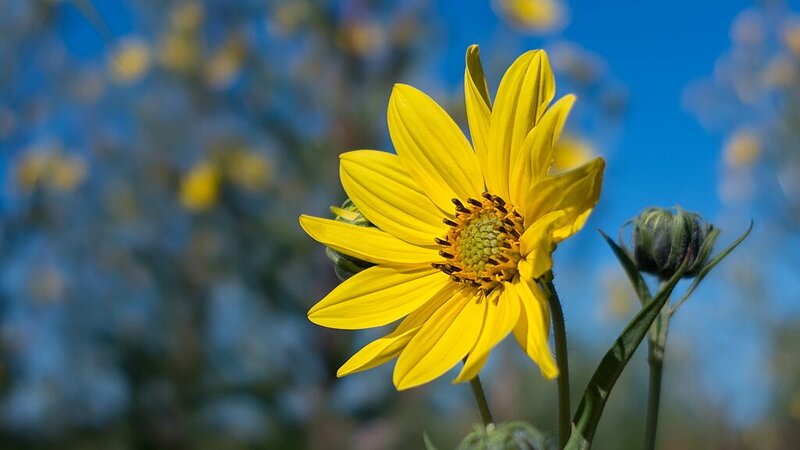
Photo Credit: Joe deSousa / Wikimedia Commons / CC0
As the name suggests, the giant sunflower is a real showstopper that grows up to 12 feet. This plant is easy to take care of and tolerates dry weather. Additionally, it’s a magnet for bees and a host for various butterfly species. Plus, its seeds are a common snack for birds.
However, be careful, because the giant sunflower is severely toxic to pets and various animals. It has some toxic effects on humans, too.
- Sun: Full sun
- Soil: Rich, moist, well-draining soil with no rocks or tree roots
- Bloom time: Mid summer to early fall
- Water needs: Drought tolerant; should get an inch of water per week
- Mature height: Up to 12 feet
- Maintenance: Low
- Potential hazards: Toxic
2. Wood Lily (Lilium Philadelphicum)
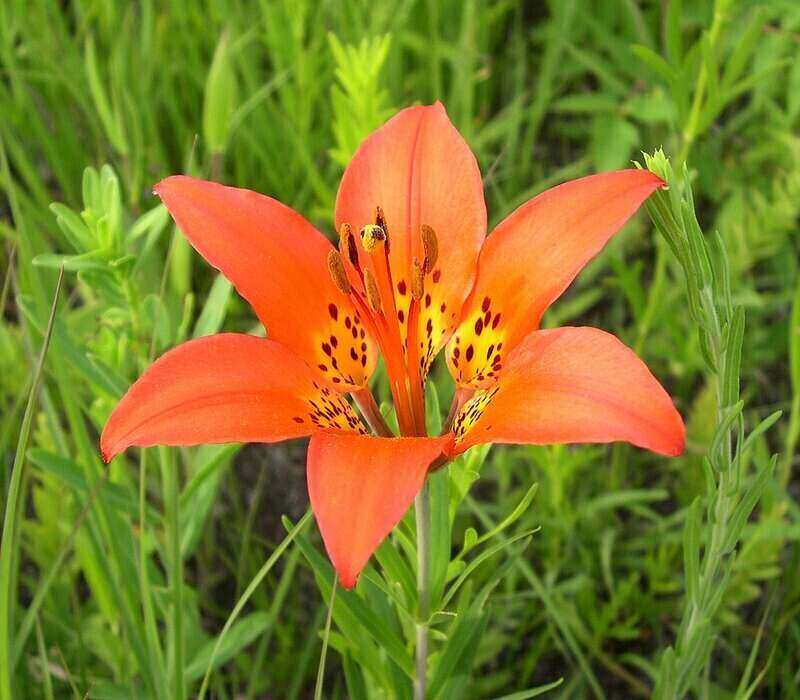
Photo Credit: Jay Sturner / Wikimedia Commons / CC BY 2.0
The showy, upward-facing blossoms of the wood lily make it a stunning addition to any landscape. The plant was once commonly seen but is now considered a threatened and endangered species in many states.
While it’s not a Delaware native, you can certainly let the wood lily accompany your yard and help its species thrive, especially if you want to attract wildlife like hummingbirds, butterflies, and even rabbits.
- Sun: Full sun or partial shade
- Mature height: 1 to 2 feet
- Soil: Moist but well-drained
- Bloom time: Early to late summer
- Water needs: Frequent watering in the growing season and when the weather is dry
- Maintenance: Medium
- Potential hazards: Toxic
3. Butterfly Milkweed (Symphyotrichum Novae-Angliae)
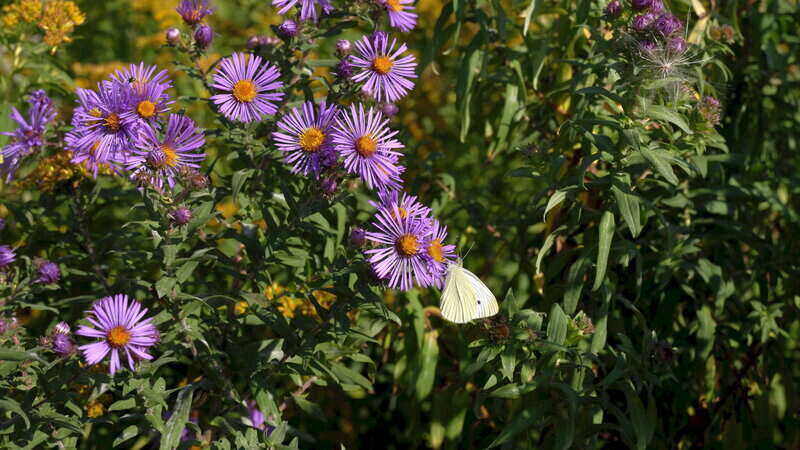
Photo Credit: PxFuel
Butterfly milkweed is resistant, beautiful, and useful to local wildlife. Within 2 years, this plant produces striking orange blossoms that serve as food for various pollinators. But that’s not the only benefit this easy-care plant offers to the local wildlife; milkweed is also the only host plant for the monarch butterfly.
Take caution, though, as this is a toxic plant.
- Sun: Full sun
- Soil: Sandy, poor, average, dry to medium, well-drained
- Bloom time: Late spring to early fall
- Water needs: Low; depending on the weather, moderate watering should suffice
- Mature height: 1 to 2 feet
- Maintenance: Low
- Potential hazards: Toxic
4. New England Aster (Symphyotrichum Novae-Angliae)
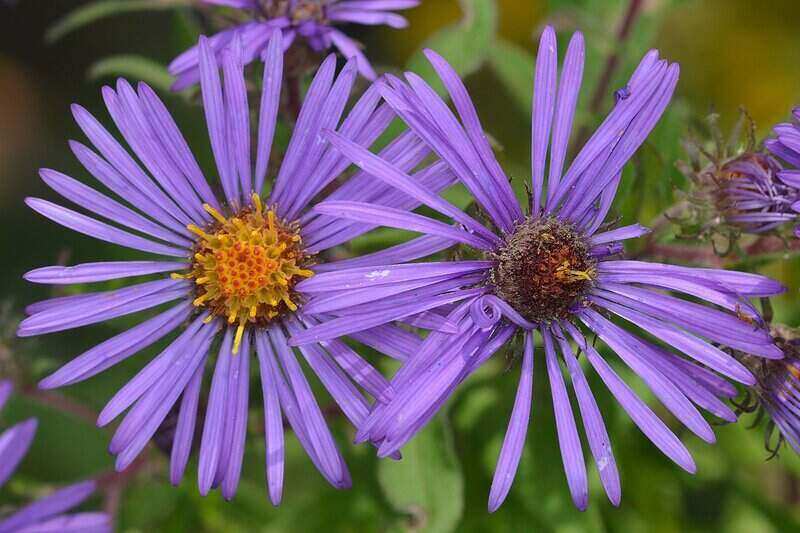
Photo Credit: Ryan Hodnett / Wikimedia Commons / CC BY-SA 4.0
The charming New England aster produces delicate, purple petals that are a pleasure to grow in any landscape. This plant also feeds wildlife like bees and butterflies, and it’s a great cut flower for arrangements. If you’re in the market for low-maintenance plant options, New England aster is a fitting choice because it doesn’t need much watering and can often just live off rainwater.
- Sun: Full sun to partial shade
- Soil: Clay, high organic matter, good drainage, moist, occasionally dry
- Bloom time: Late Summer and Fall
- Water needs: Water weekly or when the topmost layer of soil dries out
- Mature height: 3 to 7 feet
- Maintenance: Medium
Potential hazard: None known; caution is always advised, though
5. Purple Coneflower (Echinacea Purpurea)
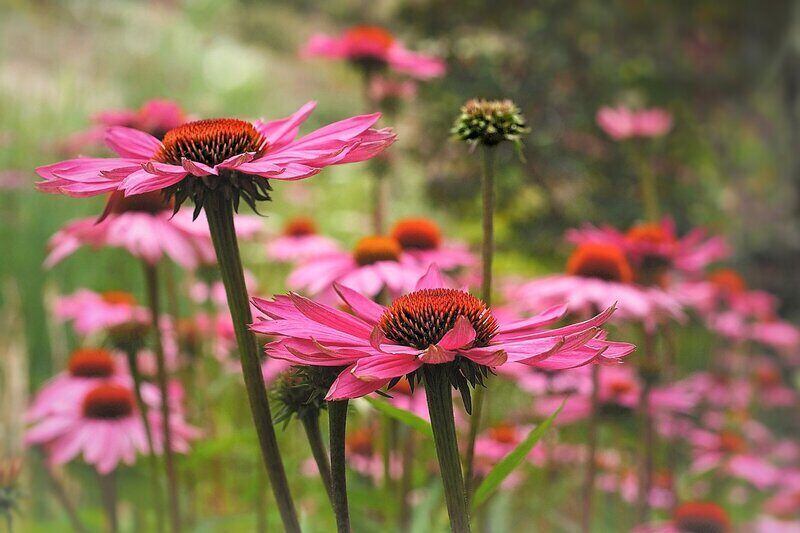
Photo Credit: Pixabay
If you want a real showstopper, purple coneflower may be what you’re looking for. Its pink-purple flowers are not only stunning to look at, but they attract wildlife such as butterflies, hummingbirds, and songbirds. The plant may, however, sometimes suffer from diseases, so be sure to take care of it properly.
However, practice caution, as this plant is toxic.
- Sun: Full sun to partial shade
- Soil: Sandy, clay, rocky
- Bloom time: April to September
- Water needs: Medium
- Mature height: 2 to 5 feet
- Maintenance: Low
Potential hazards: Toxic
6. Black-Eyed Susan (Rudbeckia Hirta)
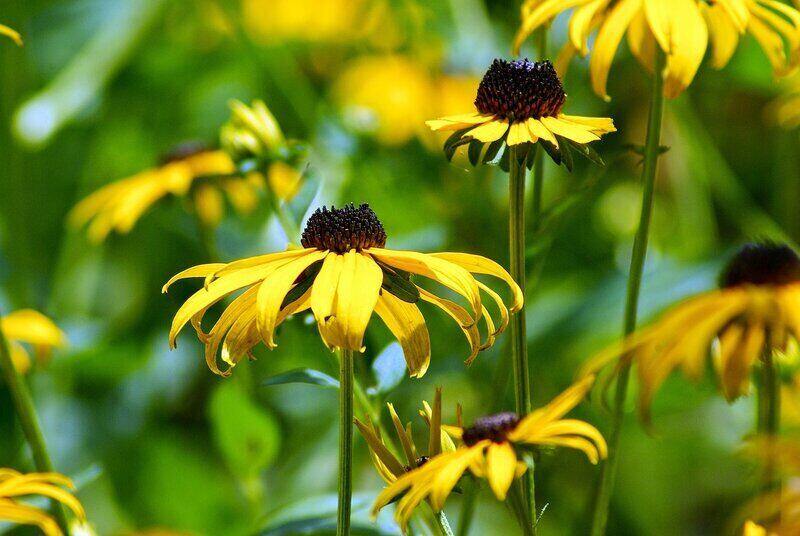
Photo Credit: PixaBay
For a yellow pop of color, you need to look no further than black-eyed Susan, also called yellow coneflower; a popular perennial that may take a long time to bloom for the first time, but once it does, it stays in bloom for months. It looks stunning either on its own or combined with its purple counterpart. Plus, it’s another favorite of bees, butterflies, and songbirds.
Although this plant is eager to reseed, other plants keep it in check. Other than that, black-eyed Susan makes an easy-care addition to your lawn. It’s adaptable and resistant to stressors like heat, drought, and cold.
- Sun: Full sun
- Soil: Clay, sand, loam, acidic, moist, well-drained
- Fragrance: Sweet
- Bloom time: Spring, summer, early autumn
- Water needs: Medium. It has moderate drought tolerance
- Mature height: 1 to 3 feet.
- Maintenance: Low. Can self-seed freely. Black-eyed Susan can become aggressive if given too perfect an environment and insufficient competition.
Potential hazards: Toxic
7. Cardinal Flower (Lobelia Cardinalis)
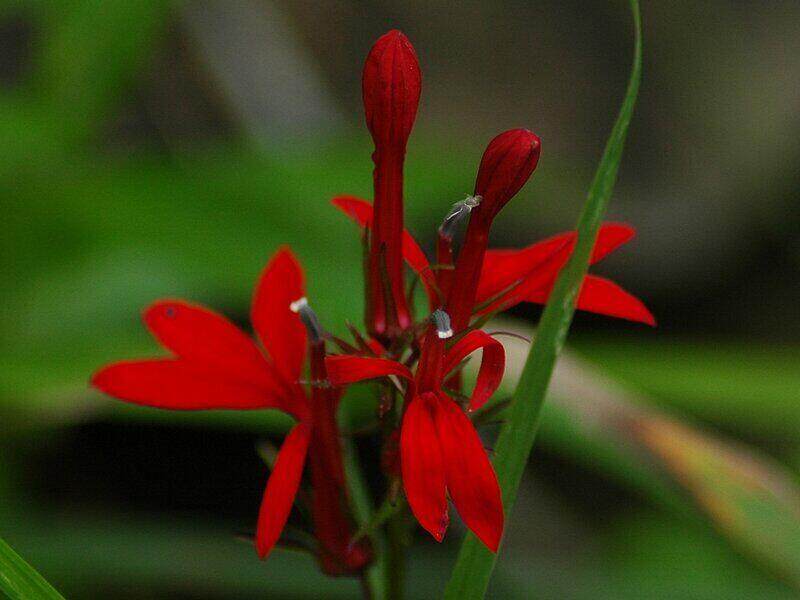
Photo Credit: linnaeus / Wikimedia Commons / CC BY 3.0
The cardinal flower blooms with vibrant red petals in the summer. Because it thrives in wet conditions, it’s perfect for a rain garden. Although it needs frequent watering, cardinal flower is otherwise easy to care for. Plus, butterflies like to snack on the flower’s nectar.
All parts of the plant are severely poisonous, though, so practice caution.
- Sun: Full sun, partial shade, full shade
- Soil: Sand, loam, clay, limestone-based
- Bloom time: July to October
- Water needs: Medium to high
- Mature height: 1 to 6 feet
- Maintenance: Low
- Potential hazards: Toxic
8. Garden Phlox (Phlox Paniculata)
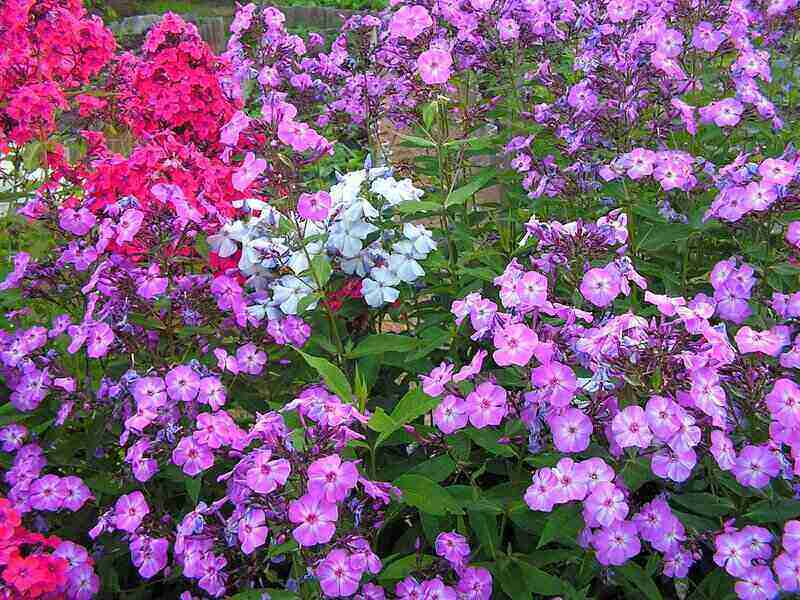
Photo Credit: Bff / Wikimedia Commons / CC BY-SA 3.0
Garden phlox is a showy perennial that grows in forests, woodlands, prairies, and other natural habitats. It blossoms with pink, purple, or white dome-shaped clusters that can make any landscape look stunning.
Phlox species are usually not toxic, but there’s a lack of data surrounding garden phlox, so practice caution. Also, take note that garden phlox is likely to encounter issues with insect pests and diseases, so it needs extra care in that area.
- Sun: Full sun to partial shade
- Soil: Clay, loam, high organic matter, good drainage, moist
- Bloom time: Mid-summer to mid-fall
- Water needs: Water in dry summers. Avoid overhead watering.
- Mature height: 2 to 4 feet
- Maintenance: Medium
Potential hazards: None known (lack of data); caution is always advised
9. Lance-Leaved Coreopsis (Coreopsis Lanceolata)
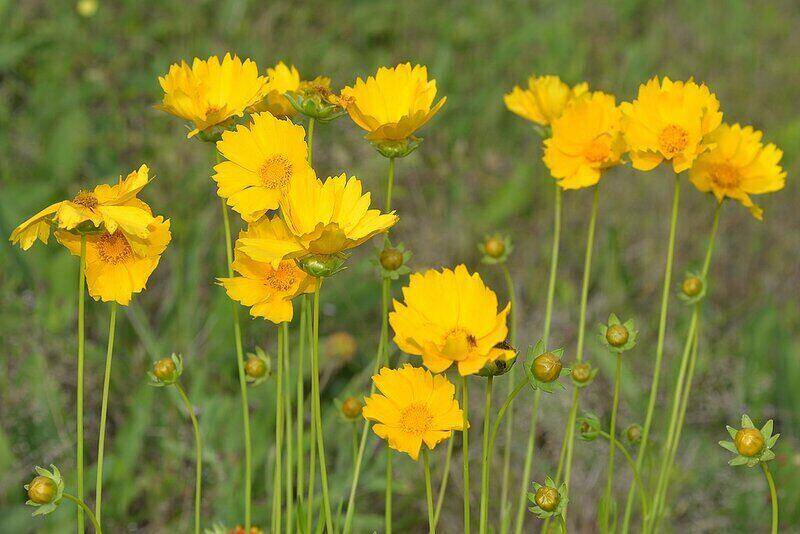
Photo Credit: William L. Farr / Wikimedia Commons / CC BY-SA 4.0
Lance-leaved coreopsis, also called tickseed, is an easy-care plant that gives your lawn that extra touch you’re looking for. When it comes to growing conditions, the plant isn’t picky; it spreads easily and grows up to 3 feet. It also resists dry, hot, and humid weather. The plant isn’t a typical perennial, but though it’s short-lived, it self-sows and produces beautiful blossoms year after year.
Usually, coreopsis species are non-toxic. But there aren’t many reports surrounding lance-leaved coreopsis, and it’s been reported as toxic to livestock. It’s always better to be cautious.
- Sun: Full sun
- Soil: Loamy, sandy, dry to medium moisture, well-drained; ideally poor, sandy or rocky soils
- Bloom time: Late spring to mid summer
Water needs: Drought-tolerant; but will benefit from regular watering, especially when soil is dry; needs regular watering before it’s established - Mature height: 1 to 3 feet
- Maintenance: Low
Potential hazards: Some reports of toxicity
10. Wild Bergamot (Monarda Fistulosa)
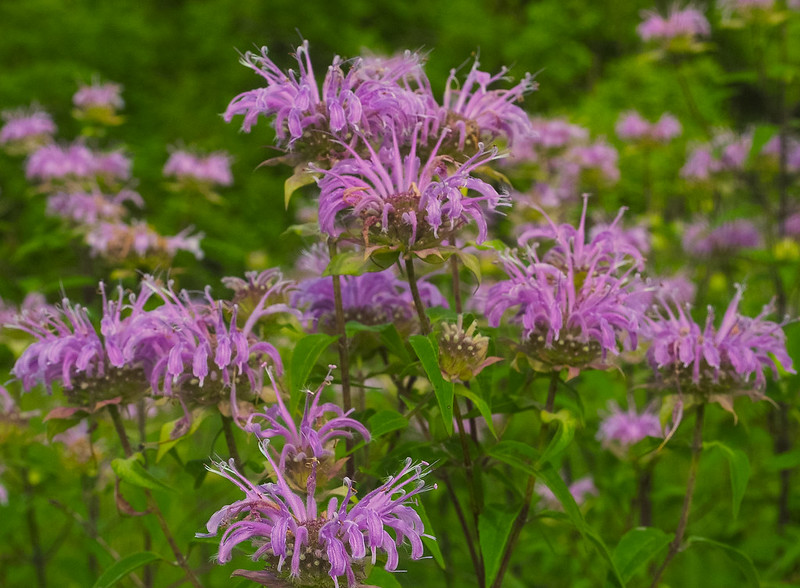
Photo Credit: Joshua Mayer / Flickr / CC BY-SA 2.0
If you like showy, fragrant flowers, you’re in for a treat. Wild bergamot is an atypical pink, purple, or white perennial in the bee balm family that smells like a mix of mint and oregano. Because it’s a wildflower, wild bergamot doesn’t take too much care for it to grow well in your yard. Moreover, it attracts various bees, butterflies, and hummingbirds.
- Soil: Full sun or partial shade
- Soil: Well-drained but moist, sandy loam, loam, or clay soil; adapts to various soil types
- Bloom time: Late spring to mid fall
Water needs: Needs to be watered once per week when the weather gets hot - Mature height: Up to 5 feet
- Maintenance: Low
Potential hazards: Consuming this plant poses some serious risks for pregnant women, nursing women, and children; excessive consumption is unsafe for pets; practice caution
FAQ
While annual plants live for one season, perennial plants grow year after year. However, annuals are known for their vibrant colors, and some of them self-seed.
It’s best to plant perennials in fall or spring, but you can plant them at any time of the year before the ground freezes.
Delaware’s hardiness zone is 7, meaning that its lowest annual temperature is around 0 to 10 degrees Fahrenheit. Any plants you get should match this hardiness zone.
When to Hire a Landscaping or Lawn Care Pro
Now that we’ve gone through 10 perennials that thrive in Delaware, you have various options to choose from. Make sure to research each plant thoroughly before adding it to your garden and take the necessary precautions to avoid any potential hazards. With the right care and attention, these perennials can add beauty and color to your outdoor space for years to come.
But choosing the right plant isn’t the last step to creating a beautiful yard. You also need to care for it. If you’d like some help with that, Wikilawn connects you to the best landscaping and lawn care pros in Delaware.
Main Photo By: Hippopx